#Indian craftsmanship
Explore tagged Tumblr posts
Text

Exquisite Banarasi Tissue Silk Saree – A Symphony of Tradition and Elegance ✨
Add timeless beauty to your wardrobe with this stunning Banarasi Tissue Silk Saree, woven with intricate craftsmanship and an undeniable aura of royalty. The luxurious tissue silk fabric gleams with a delicate shimmer, making it perfect for special occasions, weddings, or festive celebrations.
Featuring traditional Banarasi motifs like paisleys, florals, and ornate borders, each saree is a work of art. The soft, yet striking texture of the tissue silk enhances the beauty of the handwoven patterns, creating an ensemble that is both graceful and bold.
🌸 Fabric: Premium Tissue Silk 🌸 Design: Intricate Banarasi motifs and zari work 🌸 Occasions: Weddings, Festivals, Celebrations 🌸 Style Tip: Pair it with traditional jewelry for a regal look!
This piece embodies the rich heritage of Banarasi craftsmanship while offering a modern twist that suits every occasion. Whether you're attending a wedding or a cultural gathering, this saree ensures you'll be the center of attention. ✨
Let tradition meet elegance. To discover the magic of Banarasi Tissue Silk Saree visit truthfab.com
#handloomsarees#bridalsarees#indiansarees#designersarees#banarasisaree#indian wedding saree#art#fashion#fashionista#banarasiart#indian#outfit#indian fashion#silksarees#banarasi#saree#banarasi art#indian craftsmanship#indian craftsmanship art#tissue silk#tissuesilksaree#traditional wear#indian wedding#festivestyle#festivalsaree#weddingfashion#banarasisareelove#wedding saree
3 notes
·
View notes
Text

Elegant Round Aranmula Kannadi with Back Stand
#craft#indian craftsmanship#home decor#mirror#aranmula kannadi#gift ideas#unique gifts#traditional art#art and craft
1 note
·
View note
Text
Luxurious Handcrafted Shawls and Stoles from India
Luxurious Handcrafted Shawls and Stoles from India Explore the world of luxurious and handcrafted shawls and stoles from India. Discover the finest materials, intricate embroidery, and traditional techniques that make these pieces of art truly unique. From woolen stoles for men to pashmina shawls for women, we showcase the best of Indian craftsmanship.
#Indian shawls#handcrafted shawls#pashmina shawls#woolen stoles#men's shawls#women's shawls#luxury shawls#traditional embroidery#Kashmiri embroidery#Kullu Valley shawls#Himalayan wool#pure wool#soft wool#elegant shawls#warm shawls#Indian craftsmanship#artisanal shawls#luxury textiles#high-quality shawls#exclusive shawls#shawls for men#shawls for women.
0 notes
Text
"Masterpiece of Indian craftsmanship!"
The Peacock dress of Lady Curzon is a gown made of gold and silver thread embroidered by the Workshop of Kishan Chand (India)
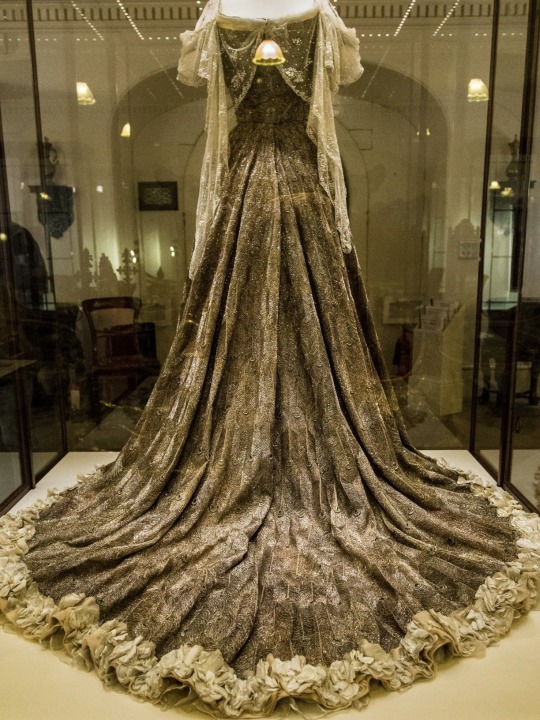

The Peacock Dress of Lady Curzon is a iconic masterpiece of Indian craftsmanship and design. Created by Indian artisans and designers, this exquisite gown was worn by Lady Curzon, the wife of the Viceroy of India, to the Delhi Durbar in 1903. The dress is a stunning example of Indian craftsmanship, adorned with intricate peacock motifs, precious stones, and metallic threads, showcasing the excellence of Indian design and artistry.
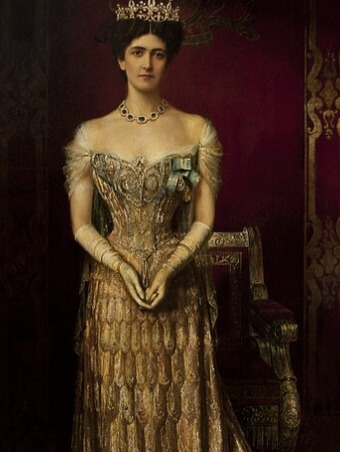
"Peacock Dress of Lady Curzon: A resplendent masterpiece of Indian design and craftsmanship, this gown is a testament to the country's rich textile heritage. Intricate peacock motifs, crafted with precision and flair, adorn the dress, showcasing the exceptional skill of Indian artisans. A true masterpiece of Indian fashion and design."
Incredible craftsmanship of Indian designer:
"The Peacock Dress is a shining example of Indian designers' exceptional skill and creativity. Every thread, every stone, and every motif is a testament to their mastery of the craft. This dress is not just a piece of clothing, but a work of art that has stood the test of time, showcasing the brilliance of Indian design to the world."
EMBROIDERY DETAILS
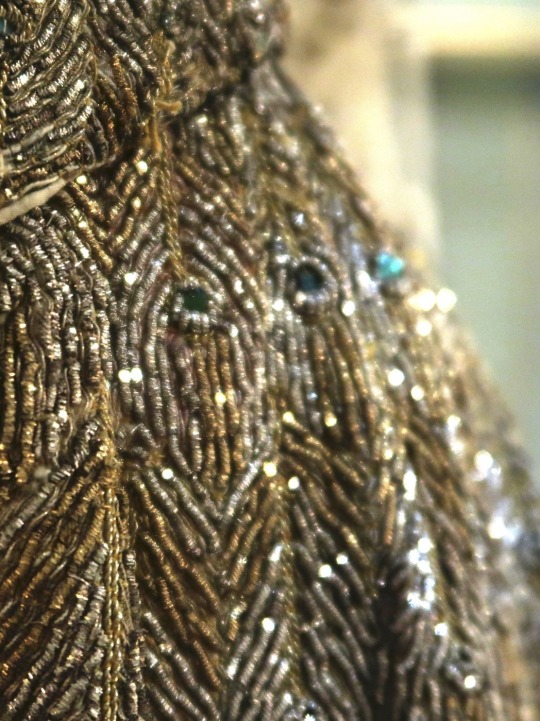

"Peacock Dress of Lady Curzon: A resplendent masterpiece of Indian design and craftsmanship, this gown is a testament to the country's rich textile heritage. Intricate peacock motifs, crafted with precision and flair, adorn the dress, showcasing the exceptional skill of Indian artisans. The embroidery work is a marvel, with delicate silk threads, precious stones, and metallic wires used to create intricate patterns, including:
- Intricate peacock feather designs, with delicate eye and wing details
- Floral motifs, with intricate stem and leaf work
- Geometric patterns, with precision-cut mirrors and beads
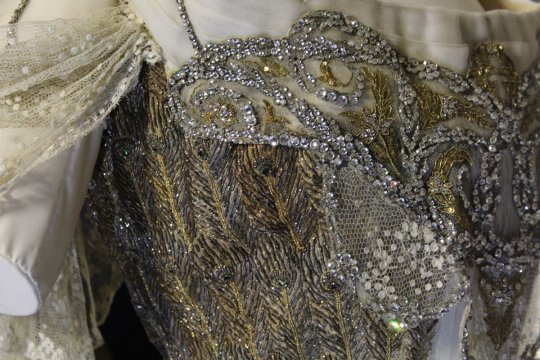
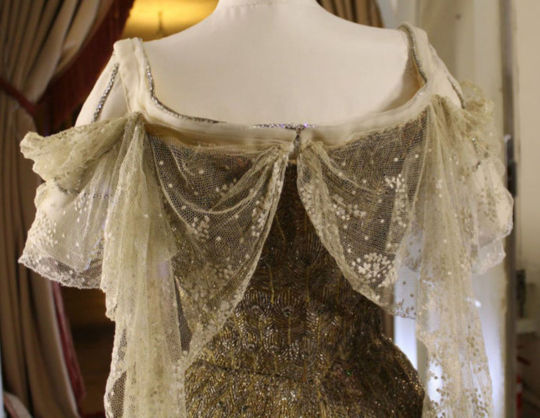
The embroidery is a masterclass in Indian craftsmanship, with techniques like zardozi, zari, and chikan work used to create a truly regal and awe-inspiring piece. Every thread, every stone, and every motif is a testament to the mastery of Indian designers and artisans."
#desiblr#desi tumblr#desi tag#desi aesthetic#desi#desi academia#indians#India#vintage#fashion#british rule#colonialism#indian artist#indian art#indian aesthetic#outfit#craftsmanship#fashion designer#incredible india#being desi#lady Curzon#embroidery#indian history
115 notes
·
View notes
Text

Mughal gem-set jade-hilted dagger (khanjar), India, 18th/19th century. watered steel curved blade.
#indian art#mughal#khamjar#antique dagger#antique knife#knife#knives#asian art#metalwork#craftsmanship#mine
9 notes
·
View notes
Text

Illuminate your space with the natural beauty of Aman Art Bamboo Handicrafts! Our Bamboo Rattan Chandelier casts a coastal charm, bringing warmth to any room. Elevate your style with sustainable elegance. 🌿💡
DM on Instagram Aman Art & Bamboo Handicrafts
Whatsapp No- +91- 09101500051
Follow this link to view our catalogue on WhatsApp: https://wa.me/c/918399889018
We are the largest Bamboo & Cane products manufacturer of the 🌍 From ASSAM (Nalbari) INDIA
https://g.co/kgs/hU5Nrp
Amanur Hoque
#BambooGlow #AmanArtBamboo #CoastalLighting #SustainableStyle #BambooGlow
#AmanArtBamboo
#CoastalLighting
#SustainableStyle
#HandcraftedElegance
#NaturalMaterials
#RattanChandelier
#BambooLampshade
#EcoFriendlyDecor
#ArtisanCraftsmanship
#bamboo#assam#idian bamboo#art#artwork#indian handmade#indianhandicraft#bamboo india#craftsmanship#crafts
2 notes
·
View notes
Text
Top Carpet Manufacturers in India: Weaving Tradition and Innovation
Rug manufacturing is surely one of the esteemed arts from the country.Today, India is among the world's largest exporters of handmade rugs, its manufacturers marrying centuries-old craftsmanship with contemporary design to feed a global market.
Conventionally, rug-making has been associated with centers like Bhadohi, Mirzapur, Jaipur, and Kashmir. Each region has its typical style and weaving technique. For example, Kashmir is famous for its silk rugs of high quality, usually with flowing floral motifs, while Bhadohi is characterized by geometrical patterns in woolen rugs. These skills have been passed on from generation to generation, maintaining the heritage and authenticity of Indian rugs.
Blending in New Ideas in Rug Manufacturing
Even though Indian manufacturers give maximum importance to traditional ways of manufacturing rugs, innovation is found in order to be aligned with modern taste and global trends. This fusion of old and new is something that makes Indian rugs different in the international market. There is a rise in experiments with new materials, designs, and technologies for making rugs that are not only pleasing aesthetically but eco-friendly and durable.
Another significant innovation hitting the Indian rug industry is eco-friendly materials.handmade rugs india With people starting to become more aware of the deteriorating environment, most manufacturers have started going green either in natural dyes, organic wool, or recyclable materials for their production. This does not only reduce the environmental impact but also appeals to those consumers who want home decor that is sustainable.
From the design point of view, this has broken the mold of traditional patterns as Indian rug manufacturers include contemporary styles. Most modern Indian rugs boast an abstract design, minimalistic patterns, or a vivid color palette that appeals to the taste of a young, more design-conscious consumer. Meanwhile, there is an interesting trend that looks toward timelessness whereby traditional motifs are mixed with modern tastes. The result is timeless yet trendy rugs.
Top Indian Rug Manufacturers
A few Indian rug manufacturers have carved a niche for themselves among the top-rated names of the global market in terms of both quality and innovation. Companies such as Obeetee, Jaipur Rugs, and The Rug Republic are only a few to name that exude the blend of tradition with modernity.
Obeetee is amongst India's oldest and most reputed rug manufacturers, with its base in Mirzapur.Handmade Rugs Manufacturer Founded as early as 1920, it has had ample time to establish itself in the high-quality art of manufacturing rugs by hand. Very well known, Obeetee goes for traditional craftsmanship in weavings apart from including modern elements in its designing. The company is also at the vanguard in terms of sustainability, using eco-friendly materials and practices in production.
Innovation in Jaipur has become coupled with Jaipur Rugs, an Indian enterprise based out of Jaipur. Directly working with artisans in rural India, the company provides resources and support to skilled artisans who can create this art of beauty in handmade rugs. In addition, Jaipur Rugs is known for its contemporary designs and social impact initiatives that are undertaken to uplift and empower local communities.
Then there is the Panipat-based enterprise known as The Rug Republic, which is another major player in this field.Rugs manufacturers in india It specializes in modern, eco-friendly rugs manufactured from recycled materials. Innovative approaches to design and sustainability make The Rug Republic the favorite of consumers in search of stylish and environmentally conscious home décor options.
Conclusion
The success of rug manufacturing in India comes from the perfect balancing of tradition with innovation. While preserving ancient techniques, Indian rug manufacturers also use new materials, designs, and technologies to create products finding their place in the hearts of every consumer all over the world. As these manufacturers keep evolving, they are not only keeping the rich rug-making heritage of India alive but setting new standards for quality and creativity in the global market.
#Rug manufacturing is surely one of the esteemed arts from the country.Today#India is among the world's largest exporters of handmade rugs#its manufacturers marrying centuries-old craftsmanship with contemporary design to feed a global market.#Conventionally#rug-making has been associated with centers like Bhadohi#Mirzapur#Jaipur#and Kashmir. Each region has its typical style and weaving technique. For example#Kashmir is famous for its silk rugs of high quality#usually with flowing floral motifs#while Bhadohi is characterized by geometrical patterns in woolen rugs. These skills have been passed on from generation to generation#maintaining the heritage and authenticity of Indian rugs.#Blending in New Ideas in Rug Manufacturing#Even though Indian manufacturers give maximum importance to traditional ways of manufacturing rugs#innovation is found in order to be aligned with modern taste and global trends. This fusion of old and new is something that makes Indian r#designs#and technologies for making rugs that are not only pleasing aesthetically but eco-friendly and durable.#Another significant innovation hitting the Indian rug industry is eco-friendly materials.handmade rugs india With people starting to become#most manufacturers have started going green either in natural dyes#organic wool#or recyclable materials for their production. This does not only reduce the environmental impact but also appeals to those consumers who wa#From the design point of view#this has broken the mold of traditional patterns as Indian rug manufacturers include contemporary styles. Most modern Indian rugs boast an#minimalistic patterns#or a vivid color palette that appeals to the taste of a young#more design-conscious consumer. Meanwhile#there is an interesting trend that looks toward timelessness whereby traditional motifs are mixed with modern tastes. The result is timeles#Top Indian Rug Manufacturers#A few Indian rug manufacturers have carved a niche for themselves among the top-rated names of the global market in terms of both quality a#Jaipur Rugs
0 notes
Text
The art of Decorating in Indian Style
The art of decorating in Indian style is governed by its cultural diversity and the richness of traditions, ancient text called Vaastu which is similar to feng shui. Beautifully elegant and stylishly happy, radiating positivity, Vaastu or the yoga of interiors combines interior décor with the ancient traditions of Vedas. The balance of energy is very important in creating a home that is happy an…

View On WordPress
#antique door#Antique Doors#antique indian doors#Antique Style Home Furnishings#Antique Wood Craftsmanship#Antique Woodwork#artisan doors#Artisanal StudioDoor#Authentic Period Pieces#barn doors#barndoors#bathroom barn door#bedroom doors#bypass doors#carved architectural Doors#carved barn doors#carved barndoor#carved door#carved door panels#carved doors#carved interior doors#Collectible Antiques#Custom Door#custom doors#Custom Sliding Door#Elegant Heritage Furniture#Historic Furniture Pieces#interior designer#Old World Charm Furniture#Period Furniture
0 notes
Text
Shop Now for Ethnic Warehouse's Chikankari Saree - Ethnic Warehouse
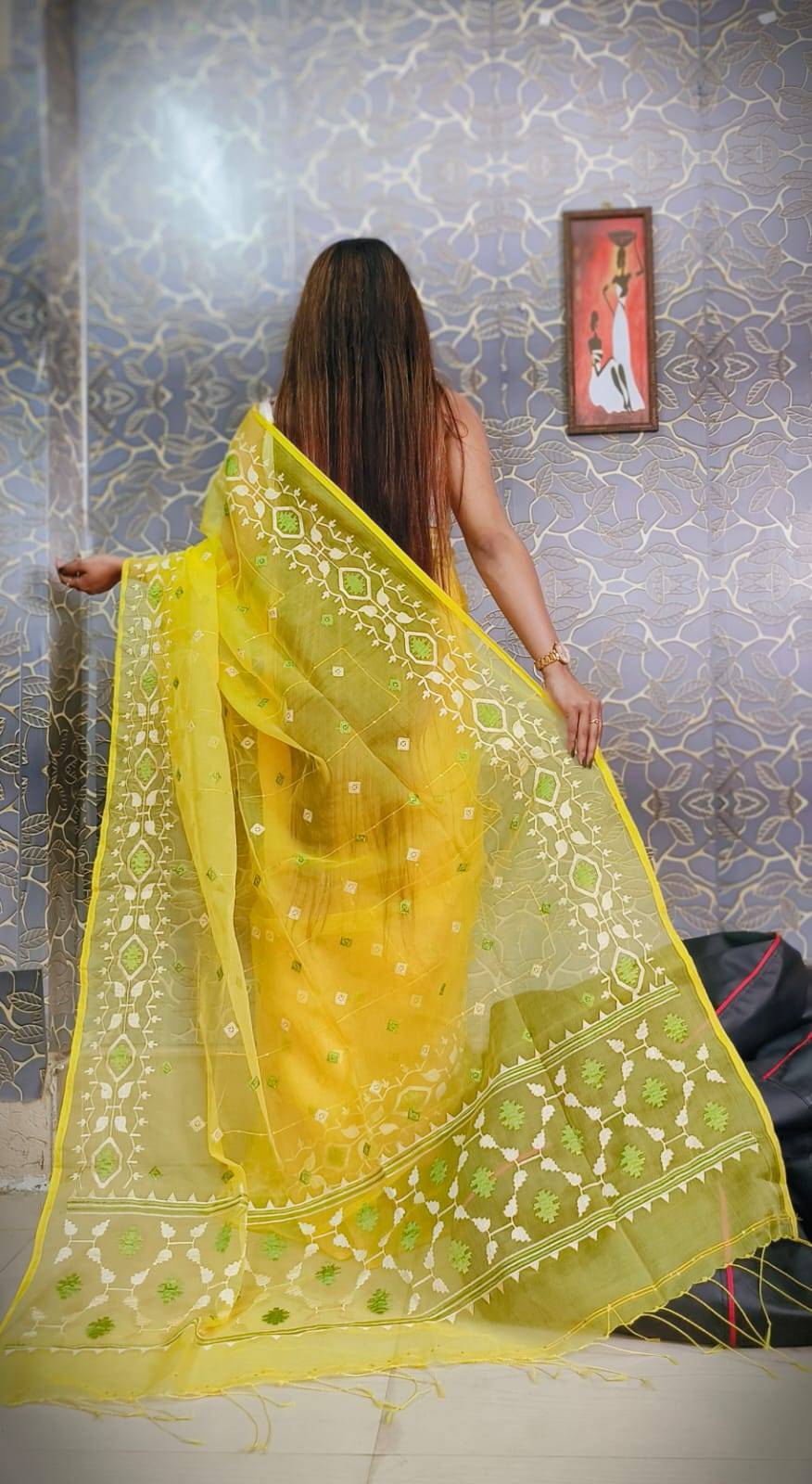
Embrace the artistry of Chikankari Sarees at Ethnic Warehouse. Shop now to discover the elegance of this intricate embroidery technique. Our curated collection embodies the perfect fusion of tradition and contemporary style. Each saree is a testament to India's rich cultural heritage. Experience the timeless beauty of Chikankari sarees, available exclusively at Ethnic Warehouse. Elevate your elegance and celebrate the charm of Indian textiles.
#Shop now for Ethnic Warehouse's Chikankari saree#Elegance and beauty of yellow and red saree#Timeless traditional craftsmanship in Chikankari sarees#Soft and lightweight fabric for comfortable wear#Hakoba detailing on traditional ethnic saree#Intricate chikankari embroidery and mirror work saree#Traditional Indian clothing for special occasions#Buy Chikankari saree with Hakoba body online
1 note
·
View note
Text
Discover the Elegance of Chanderi Handloom Sarees: A Timeless Craft
Handloom sarees hold a timeless allure in India, cherished for their intricate craftsmanship, opulent fabrics, and stunning designs. Among these, Chanderi sarees, hailing from the heart of Madhya Pradesh in Chanderi town, stand out as a testament to this enduring tradition. Chanderi sarees are renowned for their ethereal, lightweight fabric and delicate silk embroidery. Crafted entirely from…

View On WordPress
#chanderi sarees#COTTON SAREES#craftsmanship#elegant sarees#handloom sarees#heritage#indian sarees#party sarees#SILK SAREES#timeless craft#traditional sarees#wedding sarees
0 notes
Text

At the heart of the Banarasi saree lies the skill of the weavers who work on the handlooms, the craft passed down through generations. These handlooms are typically operated by skilled artisans who devote hours, sometimes even days, to weaving a single saree. The painstaking effort involved in creating fine patterns, motifs, and textures using traditional techniques significantly elevates the saree's cost. Unlike machine-made fabric, each Banarasi saree is unique, with imperfections that add to its character and charm.
If you’re looking for a beautiful pure handloom georgette meenakari saree, you can look at once at Truth Fab. Our range of elegantly crafted sarees guarantees you’ll discover the ideal piece for every occasion.
#handloomsarees#bridalsarees#indiansarees#designersarees#banarasisaree#indian wedding saree#indian outfit#indian fashion#silksarees#banarasi saree#art#fashion#banarasiart#banarasi art#indian craftsmanship#indian craftsmanship art
2 notes
·
View notes
Text
7 POC Architectural Inspirations for Your Fantasy World
Fed up with (most) authors sticking to the Renaissance ‘white’ castles so here’s some inspiration (and a gentle nudge to branch out because I can’t stand them anymore):
1. Mahals (India)
Ornate domes, intricate carvings, and symmetrical layouts. Mehals take decades to be made and are intricately brought to life with beautiful detailings, take the Shish Mahal's mirror work, Jharokhas, the Pietra Dura Mughal inlays, and classic Jaali work that female characters sneek peeks through to watch the throne room from afar.
2. Qilā (Fortresses of the Mughal Empire)
If you want something more in tune with a war-based story Qilas are a good option. They’re brought to life with massive stone walls, gateways with pointed arches, and courtyards for strategic defense. Qilas are intended for protection but many hold a rustic mix of Persian and Indian architecture which provides that aesthetic charm writers like.
3. Shiro (Japanese Castles)
Shiros are Japanese castles with many buildings within their walls, such as the Goten (palace). I used a Shiro for my book and it is so convenient if you have a larger cast, like a court system/multiple families. If you want to know all the structures, names, what they look like, etc. just google ‘Nawabari’ (the Japanese term for a Shiro’s layout).
4. Kasbahs (North Africa)
Kasbahs are native to Morocco and perfect if you need something minimalistic yet pretty. Their structures are very similar to that of a Qila since they both have a pragmatic, angular build. However, Kasbahs are more earthy with thick clay walls, small windows and subtle yet pretty detailing.
5. Qasr (Middle Eastern Palaces)
Qasrs are Arab palaces that feature ancient Bedouin architecture. However, there is no ‘one size fits all’ Qasr because this word is used to describe both palaces and forts. You can have a ‘qasr’ that is a palace with sprawling courtyards, marble arches, and curvy turrets, or a ‘qasr’ that is a Bedouin fort with structured cylindrical towers. PS: castle = Qusur.
6. Baray Temples (Cambodia)
Barays, like those at Angkor Wat, symbolise spirituality. Like many Asian temples, they are typically surrounded by water and reservoirs. The complexes feature intricate stone carvings, steep steps, and a flat triangular top (Google if you cant visualise it please). Unlike most structures on this list, they are typically made using Laterite or Earth/clay.
7. Mudbrick Mosques (West Africa)
While South Asia uses intricate craftsmanship for their detailing, Mudbrick Mosques have smoothly carved pillars, tapering walls and flat domes that are strategic yet beautiful. The beige tones blend seamlessly into the dessert with wooden beams protruding from its walls to make it stand out. I would recommend looking at the Great Mosque of Djenné; truly a masterpiece.
I've mainly covered types I've either seen irl or used in my writing please don't come at me if I haven't included something from your culture, you can comment it.
Looking For More Writing Tips And Tricks?
Check out the rest of Quillology with Haya; a blog dedicated to writing and publishing tips for authors!
Instagram Tiktok
#hayatheauthor#haya's book blog#haya blogs#writing community#quillology with haya#writing tools#writer things#writing advice#writer community#writing techniques#writing prompt#writing stuff#creative writing#ya writing advice#writing tips and tricks#writer tools#writers of tumblr#writer blog#writers block#quillology with haya sameer#writers on tumblr#writerscommunity#writer stuff#author help#author advice#author#writing inspiration#writeblr#novel writing#on writing
512 notes
·
View notes
Text
Patola Sarees: A Vibrant Tapestry of Indian Craftsmanship
The Vibrant Tapestry of Patola Sarees

Patola sarees are renowned for their exceptional beauty, showcasing a vibrant array of colors and intricate designs. While some Patola sarees feature a plain body with a contrasting border and zari work, the more common varieties boast detailed patterns and motifs across the entire fabric. These sarees are celebrated for their flaming bright colors, each one unique in its design, reflecting the imagination and skill of the weaver.
The Mastery of Patola Weaving
Patola sarees are considered among the finest textiles produced in India, primarily woven in the regions of Gujarat and Andhra Pradesh. Like the intricate tie-and-dye technique, Patola sarees are manually tied and dyed, using natural dyes derived from vegetables and flowers. There are two main types of Patola sarees: the Rajkot Patola, which features a single Ikkat (resist-dyed) pattern, and the Patan Patola, which showcases a double Ikkat design - a highly complex textile technique.
The Enduring Legacy of Patola
The creation of a Patola saree is a meticulous process, taking anywhere from four to six months to complete, depending on the design. The double warp and weft construction of Patola sarees ensures that the fabric is exceptionally durable and can be passed down through generations. Historically, Patola sarees were reserved for the royalty, with only the wealthy able to afford these exquisite textiles. Today, while still considered a luxury, Patola sarees have become more accessible, though they remain highly sought after by both Indian and international buyers.
The Enduring Charm of Patola
Patola sarees have maintained their popularity over the centuries, never going out of fashion and always in demand, particularly among the upper and middle classes. While not considered a craze, Patola sarees have become an integral part of many women's wardrobes, appreciated for their timeless elegance and affordability. The vibrant colors, intricate designs, and exceptional craftsmanship of Patola sarees continue to captivate and inspire, preserving the rich cultural heritage of this iconic Indian textile.
#indianfashion#designer#indianwear#clothing#sarees#style#womenswear#dresses#lifestyle#fashion#Patola sarees#Indian fashion#textile craftsmanship#traditional weaving#natural dyes#double Ikkat#Rajkot Patola#Patan Patola#cultural heritage#vibrant colors#affordable luxury
0 notes
Text

Japanese craftsmanship sings in every room. The octagonal pass-through window is a perfect circle on the kitchen side. The cupboard's wooden doors slide effortlessly in any weather without metal fittings. The dining table, made of rare Indian laurel, and the cherry wood chairs are by the late George Nakashima, who was considered the elder statesman of the American crafts movement.
At Home With Japanese Design: Accents, Structure and Spirit, 1990
#vintage#vintage interior#1990s#90s#interior design#home decor#dining room#Indian#laurel#cherry#furniture#chairs#George Nakashima#craftsman#shoji screen#minimalist#Japanese#style#home#architecture
446 notes
·
View notes
Text


youtube

"I've got a Big Chief, Big Chief, Big Chief of the Nation
The wild, wild creation
He won't bow down
Down on the ground
Oh how I love to hear him call Indian Red"
Voices of a Nation – "Indian Red"
The Backstreet Bar used to be the spot Celeste's parents went to when they were young and lively in the nineties and before they started pumping out kids left and right. Near the French Market off Esplanade in the sixth ward, it became a shrine and the iconic hub for rhythm and blues.
All things Black and New Orleans culture-wise sprang from that bar in their neighborhood. When the owner Etienne King passed away, his widow Lesli King took over. The levees broke in 2005 and nearly washed away the people and history that gave the city its culture and flavor. But the people persevered until Lesli passed during Mardi Gras of 2010. Celeste remembered 2010 well because it was the first year she started sewing with her granddaddy Big Chief Harris Profitt of the Wild Treme Mardi Gras Indians.
Thirteen and full of spitfire energy and overzealous gumption, Celeste spent all year beading and sewing using her granddaddy's jeweler's loupe magnifier over her right eye. The intricate beadwork and patches she sewed and assembled to make her first Indian suit was a proud moment, not only for Celeste, but for that side of her family who ran up and down the streets hunting down other tribes to battle in verbal dexterity and showing off how pretty they looked in their Mardi Gras finery.
Her suit was a patchwork of dark purple, lavender, and white micro beads, feathers, and sequins. She showed the fuck out among her kin and her relatives started calling her by the nickname Duchess because she strutted so high and mighty in front of granddaddy's house while the neighbors waited for their Big Chief to come outside on a fine Mardi Gras morning to represent their downtown neighborhood in his fabulous three-dimensional African-inspired suit. No one in Treme ever called her grandfather by his first name. It was always "Big Chief", "Chief", or "Chief Profitt".
Proud to be a Wild Treme Indian, Celeste sewed a new suit every year as was custom. It was expensive, time-consuming, and a true labor of love. Her grandmother had worked as a seamstress for a dress shop and her grandfather was a welder like his father before him, and she absorbed those technical skills of sewing and shaping metal under their tutelage to transform Black Mardi Gras Indian regalia into wearable art. Sadly, she lost interest in making suits by the time she hit twenty-four and began designing the fancy second line parasols, fans, and baskets for several social aid and pleasure clubs instead. That extra source of income helped carry her for over four years. Sometimes on annual Super Sundays she'd re-purpose some old suits to play in with other Mardi Gras Indian tribes that came from all over the city to commune and show off in A.L. Davis Park. It made Big Chief happy to see her on those occasions, although he wanted his youngest grandchild to sew new suits again.
The test of a true Indian was to pour your passion and creativity into needle and thread to kill 'em dead with a new suit annually. Tribes frowned on recycling an old suit and considered it lazy work to don a suit people already witnessed you in. People came out looking for craftsmanship, originality, and style—lagniappe—a little something extra each year. She poured her creative flair into the overly decorated accessories for other people and made a nice coin doing it.
After Lesli died, Grand-mère, along with a cadre of old-timers, lamented that the history of their hood would crumble if the Backstreet Bar died. Grand-mère had been one of dozens of foster-children Lesli looked after over the years, giving some jobs working at the neighborhood bar. Eventually, Grand-mère and Big Chief took over the property instead of retiring when Celeste turned eighteen. It was the bar Celeste headed toward for Mardi Gras Indian practice with her family and tribe.
She didn't want to drive through downtown, but she became the designated driver for three of her besties. Lyfts and Ubers raised their prices during the holiday season and no one wanted to pay outlandish fees when they could look cute in her brand new muscle car. Cruising through the Garden District, she picked up two of her friends and headed down to the French Quarter. They didn't have to stop for food because Grand-mère provided free red beans and rice, fried chicken, and sometimes boiled crawfish and red rice at the bar. She hoped they had a nice spread tonight because her stomach growled and she needed heavy food to soak up the liquor she planned to consume.
Her ex boyfriend committed a flagrant foul that weekend by jumping the gun and telling everyone they had broken up before she was ready. She suspected he wanted to bring out his new woman openly so no one would beat his behind once she blabbed that he'd been running around on her. Truth be told, she was tired of his boring ass anyway, but the general principal of the matter was she wanted to be the first to bail and get her lick back during carnival. Now if she turnt up and shook ass extra hard, people would say she was overcompensating for getting dumped.
"Duchess, turn right…slow down…there's a spot about to open up."
"Where?" Celeste said to her friend Mercy, who sat shotgun.
Mercy pointed to the flashing hazard lights of a taxi. Celeste zipped into the tight spot and breathed a sigh of relief. There was nothing worse than searching for parking anywhere near the Quarter or within a one-mile radius in any direction during the carnival season. Mercy checked her smartphone.
"She's on her way out," Mercy said.
Celeste checked her face in the mirror. Although it was only a practice at the bar, she still wanted to look cute. Her giant Medusa locs were pulled back with a leather hair tie high on her head, and her eyeliner and ruby lip stick gave enough sexy unbothered vibes that made her feel confident. She had her girls, a stellar whip that she worked hard for, and time with her tribe to look forward to. Lately, it seemed like carnival festivities were the only way her family got together en mass. Carnival or funerals.
Their friend Joyce hustled out of a popular bakery in the Quarter carrying a box of the popular King Cake, a ring-shaped, hand-braided cinnamon infused dessert. The plastic covering on top showed off the tri-colored icing of gold, purple, and green.

"Hey, girl!" Celeste said as Joyce climbed in the back of the Charger. She gave air kisses to Nae Nae in the back.
"Whew! It's been crazy in there! Some people were mad they ran out of King Cakes that weren't pre-ordered. I am ready to cut up!" Joyce enthused.
Celeste checked her driver's side mirror and pulled out, heading around the narrow block. Clogged streets packed in the tourists, locals, and plenty of cops. She parked four blocks away from the Backstreet Bar and they all climbed out feeling giddy. Normally, Big Chief didn't allow outsiders or non-tribal members to attend Indian practice. But he made an exception that year to help her get over feelings about her ex. Freddie made being in Nawlins central intolerable. He knew everyone in her extended family because he was a police officer who had connections to a political family with high ambitions for him down the road. After their unceremonious break up, she moved into a cute little over-priced cottage far from him, and took an extra part-time job at a chicken processing plant with a goal of saving enough money to head out to California for an extended visit. Celeste had relatives in L.A. and could stay with them for a vacation. Getting away from the Big Easy would help build up a new positive lease on life. Or maybe she'd take a five-day cruise to Mexico. Anywhere was good, just as long as she could escape Freddie and go to a new world for a minute.
That man had wasted her time and love. She wanted to buy a large home and get married. Start a family. Months ago, she gave him an ultimatum that their relationship needed forward momentum and her finger needed a ring by New Year's Day. Cheating was his way of humbling her, and ironically, it brought her great relief. He made life feel stagnant and dull, proving unequivocally that he wasn't The One. She just didn't have the guts to leave first before having something lined up on the horizon.
A crowd of patrons gathered outside a corner in front of the Backstreet Bar, catching the pitiful breeze that attempted to blow through the escalating muggy heat while listening to the thumping music from inside. Celeste glanced at the exterior of the bar painted with colorful images of their tribe, Creole food, and two giant beer mugs clinking together. The name of the bar was graffiti painted above the front door that stood wide open. A "Closed Until 9 P.M." sign taped to the wall kept non-tribal members out for the time being, and a blank-faced bouncer, David, stood vigil on a metal stool.
"Hey David!" Celeste said.
"Duchess!"
David hopped off the stool and gave Celeste a big belly hug because his stomach lopped over his belt.
"I brought my friends to watch with Big Chief's permission. They won't be no trouble," she said.
David looked over the women, his beady eyes taking a liking to Joyce's plump frame.
"Alright now, go get y'all a plate before the good eatin' is all gone," David said to the group. His eyes stayed on Joyce the entire time.
Inside, the raucous shouts of men showered them with the energy of the packed bar and sucked them right into the fold. Family and tribal members were already cutting up, clapping and smacking tambourines in time to an internal beat that swelled throughout the room.

On a small stage across from the bar, a second line brass band made up of young men in their twenties carried the foundational rhythm the others followed. The musical frenzy, sweaty faces, and rocking bodies enveloped Celeste in the comforts of culture. Trumpets, a trombone, and a good faith tuba blasted the familiar jazzy sounds that New Orleans was famous for. Celeste rocked her shoulders, shuffled her feet with slick footwork, and sang the old-time Indian songs.
Joyce placed the King Cake on an open table near Grand-mère who stood regally watching the action. She hugged each one of them. Celeste eyed her father drumming on stage and glanced toward her mother, who mixed drinks at the bar.
It was good to be in the Treme.
She greeted familiar faces and asked "Who dat?" about folks she didn't recognize. Inundated with love and affection, Celeste settled in, bringing a playful zeal to her dancing. Her mother handed her a tambourine at the bar, and she hopped onto the dance floor behind her grandfather and tapped a churchy beat on her left palm. Onlookers who were guests ogled the rare treat of seeing a real deal Indian practice. Their tribe's Spy Boy, Darryl, waved a white handkerchief around, yelped in his warbled tone and pretended to see another tribe's approach. A play uncle named Man-Man started strutting as their Flag Boy and the boisterous sound of voices rose, singing louder than the percussive drum beats onstage. Celeste stayed close to her grandfather, listening for his calls to change the tempo at the drop of a dime.
The Big Chief's salt and a little less pepper hair sweated out into tight curls. His dark hickory brown face stayed bathed in a sheen of earned sweat. Eyes closed and listening for the spirit to arrive, Big Chief struck his tambourine once and hooted, his cries flying overhead and joined by a tribal call-and-response that bolstered his bringing down of the ancestors.
Celeste copied his tambourine strikes to aid in catching the spirit. In four days, the tribe would take to the streets, preening and daring another tribe to outshine them. Thankful for choosing to wear a white t-shirt tied at the waist and comfy jean shorts, Celeste danced, sang, shook her hips and felt the weight of the world lift from her shoulders.
Three hours rocked by with chants, foot stomping, and plenty of drinking.
Twirling to her left to show off for her friends, she took some time to eat and gulp down a rum and coke standing in front of the stage. She caught the eye of a man lingering near her right side. Despite the many faces in the bar that blended into a chaotic blur during practice, the stranger's eyes latched onto hers and she couldn't shake them away. He was one of them pretty boys with captivating light eyes and possibly good hair that most people thought Creoles were supposed to have. Celeste's family was bone-Black Creole, the darker kind that still spoke southern, creolized French.

The man stood near some of her male cousins, and God forbid, a childhood friend named Travis X who was a five-percenter and a member of the Nation of Islam. It was impossible to miss Travis's short, high and tight fade and big shiny teeth. Still lurking in the shadows next to Travis, peeping at her moves, Mr. Light Eyes boldly stared right back at her like she was supposed to be sucked up on a plate of hot crawfish and dirty rice Grand-mère served.
Big Chief nudged Celeste to join in on the closing song. Lifting her contralto voice to support her energetic grandfather, she belted out the first opening cry of "Indian Red"
"Madi cu defio, en dans dey, end dans day…"
Their tribe repeated the words like a field holler with a tinge of the blues until everyone was on one accord. They belted out the song that represented the core of their tradition.
"We are the Indians, Indians, Indians of the nation
The wild, wild creation
We won't bow down
Down on the ground
Oh, how I love to hear them call Indian Red
I've got a Big Chief, Big Chief, Big Chief of the Nation
The wild, wild creation
He won't bow down
Down on the ground…"
Tears welled up in Celeste's eyes while singing with her grandfather. The power of the words enveloped her like a cozy patchwork quilt. Big Chief was getting to the age where he would have to pass the torch onto his oldest son. It was quite possibly his last time leading the tribe. His age was catching up to what his body couldn't carry as well anymore. The heavy tribal suits could weigh over eighty pounds or more. She wanted to dance in the streets with him one more time before a shift took place. She heard the trembling in his voice…they all did. Everyone in that packed bar knew they were witnessing the closure of an era under his leadership. Her uncle Alston would be a capable chief, but Big Chief Harris Proffit was the only chief she had known representing her people since she was a baby. He was eighty-two. Time to hand down the baton.
The last note hung in the air and Celeste broke away, grabbed her smokes from her purse, and headed outside to clear her head. Big Chief didn't need to witness her sadness. He wasn't dying, just nearing retirement. But it felt like a passing on anyway.
Back on the corner and away from David, who allowed regular patrons to come inside since practice was over, Celeste opened up a pack of Newports and tried lighting a cigarette. She flicked her lighter. It flashed and petered out. She huffed, and the cigarette dangled from her lips. A sign from God to quit, probably. A spark of another lighter glowed under her bottom lip.
Travis had followed her outside. So did the stranger and a few other men from Travis's Hotep crew.
"Sister Celeste, you know you should give up the devil's ways with this smoking," Travis said.
Celeste puffed to catch the flame, and Travis removed the lighter.
"Then why help me out?" she said.
She took a long drag and blew out away from his face and noticed a dark tattoo on the stranger's muscular right arm. An eight-pointed star floating above a crescent moon. Shit. Another Muslim. Last thing she wanted was to be lectured and recruited to be the next Betty Shabazz to a Malcolm X wanna-be. At least Travis wasn't slanging his bean pies or the Final Call at the bar. A real vibe killer. One thing the Nation had right by her was how they cleaned up Black men and turned them into fine specimens of manhood. She glanced at the tall, pretty boy with the hypnotic eyes. His plush lips looked so succulent for long, lusty kisses.
As-Salaam Alaikum, she muttered in her mind.
Her stomach fluttered at the grin on his face. Like he heard her thoughts. He turned to look at a few patrons entering the bar, and she glimpsed more ink on his left arm. A marine tattoo with black USMC lettering. An eagle sat on top of a globe underneath it, and Celeste looked away when he rested his gaze on her face again. Her cheeks warmed up like she was in a hot bath, and she parted her lips to take in more air. Feeling breathless, she jabbed her cigarette against the wall and tossed it in a garbage bin near the entrance.
"You ready, Duchess? They playing the down home blues in there and the old folks are taking over the dance floor," Nae Nae said with an annoyed stank face, joining Celeste outside with Joyce and Mercy.
Joyce handed her a paper plate with a piece of King Cake on it. Grateful for the distraction, Celeste took the plate and broke off a piece of the pastry. Stuffing it in her mouth, she chewed and Mr. Light Eyes pierced her soul with another drawn-out stare. She stuck two fingers in her mouth and pulled out a tiny brown plastic baby.

"Oop, you know what that means!" Joyce said.
Mr. Light Eyes seemed to float away with Travis and their male entourage down the street.
"I gotta bring the King Cake next year," Celeste said softly, holding the plastic baby in front of her lips, eyes still tracking the round, firm ass of the stranger in his jeans
The marine glanced back at her and smiled. She dropped her head forward, feeling lightheaded.
"You okay?" Joyce asked.
Celeste pocketed the plastic baby and linked arms with her friends.
"I'll go change inside and we'll be on our way! Let's get to clubbing!" Celeste said.
Chapter 3 HERE.
Masterlist.

Author's Note:
Hey y'all, the rest will drop on Halloween as promised! I had to set up my masterlist post now to make it easier when I upload the rest of the parts. Please share/reblog so we can get another Black fandom growing!
Tag List:
@planetblaque
@kindofaintrovert
@thedondada05
@blackburnbook
@avoidthings
@slutsareteacherstoo
@nayaesworld
@notapradagurl17
@4pfsukuna
@yamst3rdamctrl
@sweettea-and-honeybutter
@comfortzonequeen
@theereina
@brattyfics
@prettyisasprettydoes1306
@megane96
@honeytoffee
@taurusqueen83
@mightbeher
@melaninpov
@carlakeks
@woahthatshitfat
@nahimjustfeelingit-writes
#terry richmond fanfiction#Terry Richmond#rebel ridge fanfiction#Terry Richmond AU fanfiction#Black Vampires#Black Supernatural#Halloween 2024#Uzumaki Rebellion
66 notes
·
View notes
Text
HI DO YOU WANT SOME COSTUBE DRAMA THAT TURNED KINDA WHOLESOME
Pt 1: The Drama
Okay so a long-ass time ago (I think like 15 years), a British costume historian on youtube by the name of Cathy Hay decided she was going to remake 'the peacock Worth gown' and started a kickstarter for it. She made a bunch of money, but the actual work ended up being much more than she expected, so the project kept getting delayed.
In the years after, she befriended the now much more famous Bernadette Banner. They got close enough for cross-Atlantic trips to visit, etc. They were best friends and often joked that they were the same person.
Drama started riling up as people criticized Hay for not engaging meaningfully with the problematic history of the gown in question, which had been made for the wife of a British Governor of India during the 19th century, for a party celebrating British imperialism in India, and the gown's shining feature was Indian embroidery which was almost certainly underpaid, and that embroidery was the massively time-consuming bit that had been delaying her this whole time.
It was a whole thing that she sort of? Tried to address? buuuut The thing is, one of the seemingly obvious ways to manage this conflict would be to coordinate with an Indian embroiderer. In fact, a very accomplished specialist did reach out to her about collaborating on this! And she ghosted him! Maybe even blocked, I don't remember, but the thing was that he was ready and willing to do this cool project that could explore and reimagine a beautiful but morally ugly example of their shared countries' histories.
And she just… kept refusing to engage.
And then people started pointing out the weirdly predatory marketing she had for an online product/newsletter she had, and the discourse kept building as people realized overall that she was just… not as good a person as she claimed to be.
It got bad enough that Banner broke off the friendship, in large part because of that refusal to engage meaningfully with the loaded history of the Worth gown project
Pt 2: The Wholesome
So, a few days ago, Bernadette Banner released a video of her making a Regency gown. It's a very standard kind of project for her, just using old patterns and adding a touch of her own gothic tastes with historical methods to make a cool piece of clothing that explores costume history.
Halfway through, she has a call with someone she is planning to do a different video with. We don't know what the video is, but!
The thing is
The person she is having this call with
Is the Indian embroiderer, Mayankraj Singh, that Cath Hay ghosted.
And the video continues on with Banner and Singh talking about her Regency gown project and just. He ends up making an embroidered chiffon overgown with a crow motif. And it just feels very wholesome and I love to see this all coming back around.
(Okay, double-checked and apparently Hay requested a sample from Singh, and then ghosted him after she got photos of it)
In late September, another costumer, Miah Grace, released a video noting that, in 2020, Hay had requested an embroidery sample from with Mayankraj Singh, founder of the luxury fashion brand Atelier Shikaarbagh. Indian embroiderers in this shop possess skills that go back seven generations. Singh reportedly made a sample made but only sent Hay photos of it. After Hay stopped responding for many months, Singh went live on Instagram to explain what happened. Apparently, when his head embroiderer found the sample, he burned it, and scolded Singh for making it. “He said it was an inauspicious design,” Singh said, “and we do not make it anymore.” Hay later apologized to Singh, and he now considers the matter settled. - Craftsmanship Magazine
Anyway, yeah, after all of that from a few years ago, it was kind of exciting to see Banner collaborating with Singh
And she's so excited to open the package! Happy screaming!
It's so sweet.
He had his team embroider their names on the hem And she loves it
I am living for this vicarious excitement
(She does lay it on a bit thick at the end, but you know what. I'll take it.)
OH and the ending involves her attending the ball with Nami Sparrow, one of the creators of Indian background (Indian-American) that was a voice of Expertise criticizing Cathy Hay a few years ago.
Which is like. Tacit endorsement? If Singh alone wasn't enough.
Anyway yeah I lost my mind a little about this.
#phoenix liveblogs#costube#bernadette banner#cathy hay#mayankraj singh#nami sparrow#youtubers#costume history
107 notes
·
View notes